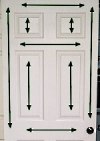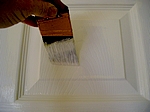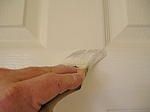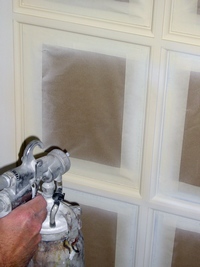Learn how to paint interior doors for a new fresh look.
The door is a main focal point of any space and painting doors can have a dramatic effect on the overall look of a room’s decor.
Many doors see a lot of use and often abuse. Properly painting doors can take care of the scratches and dings from everyday life.
Painting interior doors can be accomplished with the door removed or still hanging. This depends on your skill level when cutting in with a paint brush, unpainted or previously painted and the overall condition of the door. Plus, will the door be sprayed or painted with a brush or roller?
All of these points and the doors style will influence all decisions made concerning painting doors.
Two general door styles exist, flat and paneled. Plus different types of materials can be used for their construction. Typically we encounter solid wood, solid Masonite and hollow core doors.
- New, unpainted, solid wood doors can be paneled or slab, smooth. All unpainted doors must receive a coat of primer prior to painting. Oil base enamel under coater works best, it sands smooth and accepts any type of finish paint.
- Solid Masonite doors are available in many styles but typically have the look of a smooth paneled door. Although usually pre-primed at the factory an additional coat of enamel under coater is recommended.
- Hollow core doors are very common and are either slab or paneled. Two different materials are used in their construction, wood veneer and Masonite. Wood veneer doors are typically a smooth slab, while Masonite is paneled, often has an embossed wood grain effect.
Basic Preparation Procedures
Before you begin to paint a door, remove the doorknob and striker plate, plus any other non-paintable accessories. Clear away any obstructions and limit its use during the door painting process. New, unpainted, wood doors require sanding before priming and painting. Hand sanding with 120 or 150 grit sandpaper works well. Check the entire door for scratches dings and dents. All imperfections that can’t be removed through sanding will have to be dealt with after priming.
Clean all previously painted doors before any scraping or sanding. Cleaning will remove any residual oils left behind from repeatedly touching the door.
A liquid sander can be used in place of soap and water if the door doesn’t appear dirty; Paso is the product I use. Simple mild soap and water will work fine for mildly dirty surfaces. Heavily soiled surfaces will need TSP, trisodium phosphate. After using soap and water, precondition the doors surface with a liquid sander to remove any remaining soap film.
Remove all loose, blistered or chipped paint by carefully using a paint scraper. Apply even pressure with both hands. Be careful do not gouge the wood. Repair all dents, cracks and surface imperfections before finish sanding. Any imperfection on the surface of a smooth door will be enhanced by paint.
Bondo, auto body filler, or regular spackling paste will work best for most imperfections. Auto body filler will provide a very hard and smooth repair. Mix small amounts of Bondo at a time according to instructions. Sand ruff paint edges smooth with 80 grit sandpaper and continue sanding with 120 grit. Finish sanding with 180 or 220 grit to produce a smooth surface without deep sanding marks. For large areas use a palm or orbital sander.
Embossed Masonite doors offer many unique challenges. These doors cannot be sanded as with other types of doors. Tools that can be used are small brass wire brushes, nylon brushes and steel wool. Any patched area will stand out. While the spackling paste or Bondo is soft use a toothpick to add wood grain to a patched area. This is very difficult to do; you will need to be inventive.
After all patching and sanding, prime the entire door with oil base enamel under coater. Apply in the same order as with painting doors with a brush. Allow the primer to fully dry, this could take as little as 4 hours or as much as 24 hours. Hand sand the entire door with a fine sanding sponge or 220 sandpaper. Remove the dust with a shop vacuum and tack rags. A smooth clean surface before painting will produce a smooth finish.
Painting Doors Removed from the Frame
Painting doors can be easier when removed from the frame and either placed against a wall or on saw horses. This will allow easy access to the frame for preparation and painting. Plus all the door edges will be accessible.
- Pull the hinge pins and remove the door. This will be easier with two people.
- Place on sawhorses or lean against a wall. If extensive sanding and possible repair is needed use sawhorses. It is much easier to apply pressure on sandpaper when the door is at waist height.
- Remove the hinge leaves from the door and the frame. No need to mask or risk applying paint to the hinges.
- After sanding, screws can be installed at the 4 corners and the door suspended on the sawhorses. Use 2-1/2 or 3 inch drywall screws driven half way into the door’s top and bottom edges. Make sure the screws are installed far enough to hold the weight of the door. Add extra screws if needed. This will allow both sides of the doors to be painted at the same time. This method works great for light, hollow core, doors. For heavier doors and more control use Door Deckers, brackets that allow maneuverability with the sawhorse and easy stacking.
Another option is for spray-painting multiple doors at one time. The best method I have found is connecting each door to one another using right angle brackets, 6-8 inch work great. Attach the brackets with drywall screws and lift each door off the drop cloth with wood blocks.
Painting Doors Installed on the Frame
If you are painting doors while installed on the frame, care and skill with a brush is needed. This will allow the door and frame to be painted in one session without worrying about re-hanging the door.
Protect the hinges using blue painter’s masking tape. Masking hinges is very easy. Begin by applying blue, low adhesion, masking tape over both halves of the hinge. Run the tape over the hinge onto the door edge. Use a sharp razor knife to trim away the excess tape following the outline of the hinge.
Masking the hinges isn’t necessary if you have a steady hand and good brush.
Protect the floor from paint drips and splatters with a piece of cardboard or small drop cloth. Tape and masking paper can be used around the frame and casing.
Applying the Finish Paint
You have several options concerning the paint application. This includes brushing, rolling and spraying the finish paint. Before the paint can be applied it needs to be conditioned. For brushing, rolling or spraying use a little paint conditioner, Flotrol for water base paints or Penitrol for oil base paints. Add enough to allow the paint to flow on the surface and not be sticky. Follow the manufactures instructions.
Painting Doors with a Paint Brush
 To minimize brush marks while painting doors use a good professional paint brush plus apply the finish in sections and in sequence. The best sequence is edges, beveled areas and panels then the stiles and rails. Begin at the top and work your way to the bottom.
To minimize brush marks while painting doors use a good professional paint brush plus apply the finish in sections and in sequence. The best sequence is edges, beveled areas and panels then the stiles and rails. Begin at the top and work your way to the bottom.
The components of paneled doors are important and need to be understood. The vertical areas are called “stiles”. The horizontal areas are “rails”.
Painting paneled doors must be done in a way that defines the look of these areas. Whenever the stiles and rails meet, a straight line must be maintained. Always brush in the direction of the wood grain.
First brush all the edges. Quickly remove any thick paint on the sharp edges of the door. If using sawhorses, don’t worry about the screws on the top and bottom. These areas won’t be seen.
The second step is the beveled areas around the panels. A 1-1/2 inch brush works well on these areas, depending on the style of the door.
Next, paint the panel flats. Use full-length brush strokes immediately after applying the paint to the panels. A 2—2-1/2 brush will be needed for these large flat areas.


The rails and stiles are last when painting doors with a brush. Begin with the top rail. Then apply the paint to the stiles from the top to the next rail. Alternate between the rails and stiles until you your finished.


Don’t try to touch-up the paint when it’s wet. Trying to recoat any areas now will damage the look of the paint. Allow the paint to fully dry then repaint any areas that require another coat.
Painting Doors with a Roller
A roller can be used while painting doors and is a good option for flat slab doors or if you have several doors to paint, and not a lot of time to get the job done. The best paint roller to use is a minnie or hot dog roller with a short nap cover. These rollers are similar to mohair rollers but very skinny and only 3-6 inches in length.

Painting doors with a roller offers you two choices; leave the fine roller stipple on the door or lay-off with a brush. Your choice will be a matter of personal preference and choice of finish paint.
Oil base paints flow on a surface more than Acrylics; therefore brush marks will be less defined. Conditioning the paint will produce the best look no matter which type is used or if the door is “laid off” with a brush.
A brush is still needed for cutting in the edges or next to the hinges. If you decide to lay-off the rolled paint with a brush follow the same sequence as when brushing a door.
Rolling a door will take a little practice. Try to apply the paint evenly and not to heavy. It is best to apply two thin coats instead of a single thick one. Work the roller carefully so no roller marks or lines from the rollers edge are remaining.
Spray Painting Doors
Spraying a door is the only option for a truly smooth surface without brush marks or roller stipple. Plus with the use of an airless or HVLP sprayer many doors can be painted in very little time.

Painting doors with a sprayer will be a bit messy with overspray being a major concern. A garage or similar building will be needed. The only time spraying doors can be done in a house is with new construction.
The door needs to be properly prepared, same as all doors. Except a perfectly smooth surface, free of defects, is necessary for the best finish. Paint exaggerates all imperfections.
The easiest sprayer to use is a HVLP. This spray system will give you great control over the amount of paint applied and do it with less overspray. Unfortunately, this sprayer is slower than an airless, but using an HVLP spray gun is simple.
Airless paint sprayers can apply a lot of paint very quickly, so painting doors using an airless will require precision and control. Choosing a small spray tip and conditioning the paint will give you better control and a finer finish. A fine finish spray tip will reduce the amount of paint that is applied and proper conditioning will allow the use of lower pressure, providing better control.
A final consideration is overspray. Not only can this stuff travel and land everywhere, it will ruin adjacent doors. Overspray landing on a wet or tacky door will cause a finish similar to fine sandpaper.
One way to stop excessive overspray from landing on adjacent doors is by carefully using cardboard shields. While applying the paint hold the shield on the edge nearest the spray gun and in the direction of the overspray, difficult but possible with practice. This is more of a problem with airless sprayers.
Considerations When Painting Doors
- Keep the area clean and minimize dust while painting doors.
- If the door separates two rooms with different door colors, paint the edges to match the side that is visible when the door is open. The hinge edge matches the room the door swings from and the latch edge matches the room the door swings into.


4 Responses
Thorough, good article. But, in the interest of correct/accurate useage, the term for horizontal parts is probably not “styles”. It’s more likely “stiles”, as in “turn-stiles”. For what it’s worth.
You are correct. That is spell check at work.
your description & images showing the best order do not consider the central rail. My thinking is that these would be done before the stiles, but I could be wrong.
That is correct. On the picture I show the rails being painted after the raised panels but before the styles, #3. The rails and inner styles can be done at the same time, working down the door, with painting the long outer styles last.